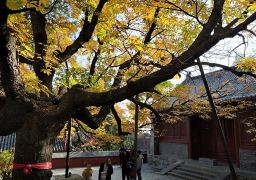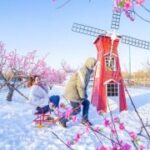# Xiangjie Temple: A Majestic Monastery Among the Eight Great Sites

Xiangjie Temple, one of the larger monasteries within the renowned Eight Great Sites, is distinguished by its gentle terrain, earning it the alternative name, Pingpo Temple. The temple’s grandeur surpasses the other seven sites, having historically served as a resting place for emperors during their mountain tours.
## Architecture and Layout
The architectural layout of Xiangjie Temple is a testament to its scale and importance. From the mountain gate to the scripture repository, the temple is built along the mountain slope, featuring six courtyards and five layers of temple halls, with grand halls and multiple gates. Upon entering, one is greeted by hundreds of stone steps that lead up to the Mahayana Gate.
### Preservation of Imperial Heritage
The temple still preserves the imperial palace and scripture repository from the Qing Qianlong period. Most of the existing buildings are relics from the Ming and Qing dynasties. The temple is centered around the scripture repository, with the eastern and western ‘Nonglou’ forming a square courtyard, flanked by bell and drum towers.
### Qianlong Imperial Palace
To the east lies the Qianlong imperial palace. The main hall houses three large Buddha statues, while the upper floor of the imperial palace is furnished with the emperor’s throne.
### Scripture Repository
The scripture repository consists of three sections; the main building contains a thousand-armed and thousand-eyed Guanyin, surrounded by four tall scripture cabinets. The left building serves as a meditation hall and kitchen storeroom; the right building houses over a hundred plaques commemorating the successive abbots.
### Front Courtyard
The front courtyard of the scripture repository is spacious and planted with rare flora such as peonies, Chinese herbaceous peonies, lilacs, hibiscus, cherries, and wisteria. Particularly precious is a Ming dynasty-planted jade iris, towering as high as the building, filling the courtyard with its rich fragrance during blooming season.
### Blooming Season
It typically blooms in late spring, with fragrant, white petals and golden stamens, said to be the only one of its kind among the Eight Great Sites.
### Eastern Qianlong Imperial Palace
The eastern Qianlong imperial palace differs from the temple in its grand scale and layout, with a front hall that leads to the Yuanyuan Zhai.
## Visiting Hours
The temple is open to visitors all year round from 08:30 to 16:30.
—









